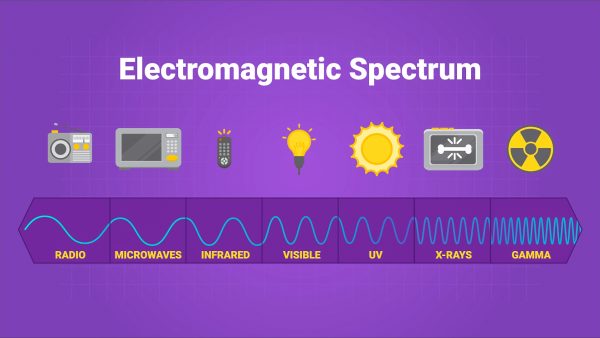Frequency Definition
Frequency is the number of waves passing a point per second. For example, higher frequency X-rays transfer more energy.
View Lesson on Electromagnetic Spectrum
Become a member to get full access to our entire library of learning videos, reading material, quiz games, simple DIY activities & more.
Become a member to get full access to our entire library of learning videos, quiz games, & more.
Plans & Pricingto watch this full video.

Access All Videos
and Lessons, No Limits.
Access All Videos

No credit card required,
takes 7 sec to signup.
No card required

Ready-to-go lessons
that save you time.
Ready-to-go lessons
If you are on a school computer or network, ask your tech person to whitelist these URLs:
*.wistia.com, fast.wistia.com, fast.wistia.net, embedwistia-a.akamaihd.net
Sometimes a simple refresh solves this issue. If you need further help, contact us.
Electromagnetic Spectrum
Fun Facts
- As you move along the electromagnetic spectrum from radio to gamma waves, the frequency increases.
- High-frequency waves, like gamma waves, transfer more energy than low-frequency waves, like radio waves.
- The wavelength and frequency of a wave are inversely related to one another, so increasing wavelength decreases frequency.
Why Do We Need To Know About Frequency
Learning about frequency helps us know how things like WiFi and microwaves work. Frequency is what makes these devices do their jobs, like letting us use the internet without wires and heating our food quickly. This idea of frequency is important because it makes a lot of our everyday technology work smoothly.
Frequency is also key in important areas like health care and space exploration. For example, doctors use it to see inside our bodies without surgery through MRI scans, and scientists study stars and planets with it. So, understanding frequency helps us make new tech, keep people healthy, and learn more about the universe.
Frequently Asked Questions
Check out the Full Lesson on Electromagnetic Spectrum
In this lesson, we learn that:
- Electromagnetic radiation is a type of wave that transfers energy.
- It includes radio waves, microwaves, infrared waves, visible light, UV light, X-rays, and gamma rays.
- The difference between all of these is the wavelength of the radiation.
Related Topics
- Absorbency Definition
- Biodiversity Definition
- Camouflage Definition
- Chloroplasts Definition
- Chromosome Definition
- Circuit Definition
- Collision Definition
- Conduction Definition
- Convection Definition
- Digital Signal Definition
- Ecosphere Definition
- Electric Charge Definition
- Electromagnet Definition
- Electromagnetic Radiation Definition
- Electromagnetic Spectrum Definition
- Fertilizer Definition
- Frequency Definition
- Friction Definition
- Heat Definition
- Inclined Plane Definition
- Internal Structures Definition
- Kinetic Energy Definition
- Law Of Conservation Of Matter Definition
- Light Definition
- Light Reflection Definition
- Limited Resource Definition
- Mitochondria Definition
- Natural Disaster Definition
- Newton’s 2nd Law Of Motion Definition
- Nucleus Definition
- Opposable Thumb Definition
- Physical Map Definition
- Pollination Definition
- Properties Of Matter Definition
- Reproduction Definition
- Seed Definition
- Senses Definition
- Soil Erosion Definition
- Star Definition
- States Of Matter Definition
- Texture Definition
- Thermometer Definition
- Total Eclipse Definition
- Trace Fossil Definition
- Watershed Definition
- Wave Definition
- Weather Definition
- Weathering Definition
Start a Free Trial Today. Get a $5 Amazon Gift Card!
Teachers! Start a free trial & we'll send your gift card within 1 day. Only cards left. Try it now.
Select Grade
Select Subject
This email is associated with a Science Kit subscription. Kit subscriptions are managed on this separate page: Manage Subscription

-
Download InvoiceScience & Math$/yr
-
Download InvoiceScience Only$/yr

access all lessons
• No credit card required •
"My students loved the videos. I started the video subscription in May and used them as a review before the state test, which I know contributed to 100% of my class passing the state test."
Rhonda Fox 4th Grade Teacher, Ocala, Florida
• No credit card required •
"My students loved the videos. I started the video subscription in May and used them as a review before the state test, which I know contributed to 100% of my class passing the state test."
Rhonda Fox 4th Grade Teacher, Ocala, Florida
• No credit card required •
Already a member? Sign In
* no credit card required *

* no credit card required *
* no credit card required *


no credit card required
Skip, I will use a 3 day free trial
Enjoy your free 30 days trial
-
Unlimited access to our full library
of videos & lessons for grades K-5. -
You won’t be billed unless you keep your
account open past your 14-day free trial. -
You can cancel anytime in 1 click on the
manage account page or by emailing us.
-
Unlimited access to our full library of videos & lessons for grades K-5.
-
You won't be billed unless you keep your account open past 14 days.
-
You can cancel anytime in 1-click on the manage account page.
Cancel anytime in 1-click on the manage account page before the trial ends and you won't be charged.
Otherwise you will pay just $10 CAD/month for the service as long as your account is open.
Cancel anytime on the manage account page in 1-click and you won't be charged.
Otherwise you will pay $10 CAD/month for the service as long as your account is open.
We just sent you a confirmation email. Enjoy!
DoneWe use cookies to make your experience with this site better. By using this site you agree to our use of cookies. Click "Decline" to delete and block any non-essential cookies for this site on this specific property, device, and browser. Please read our privacy policy for more information on the cookies we use.Learn More
We use cookies to improve your experience. By using this site, you agree to our use of cookies. Click "Decline" to block non-essential cookies. See our privacy policy for details.Learn More



























































































































